December 2022
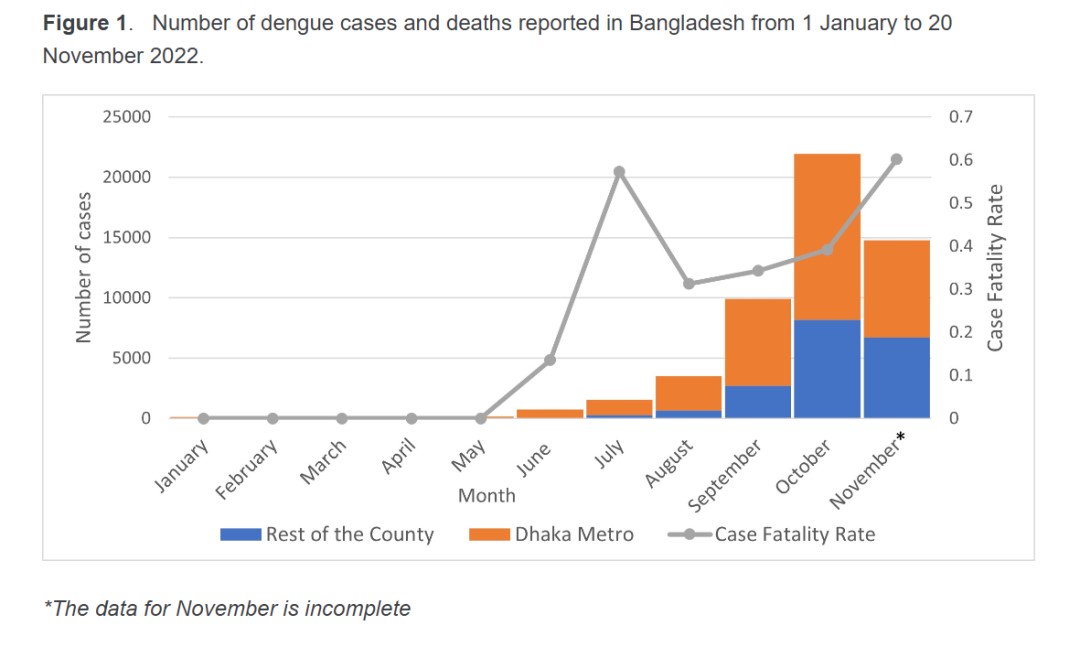
As of November 20 of this year, a total of 52,807 laboratory-confirmed dengue cases and 230 associated deaths have been reported in Bangladesh this year, with a case fatality rate of 0.44%. Although dengue is a common endemic disease in Bangladesh, a surge in cases since June 2022 remains unusual.
Several studies suggest that this year's high incidence of dengue cases is occurring against a backdrop of unusual rainfall since June 2022, accompanied by high temperatures and high humidity, leading to an increase in mosquito populations across Bangladesh.
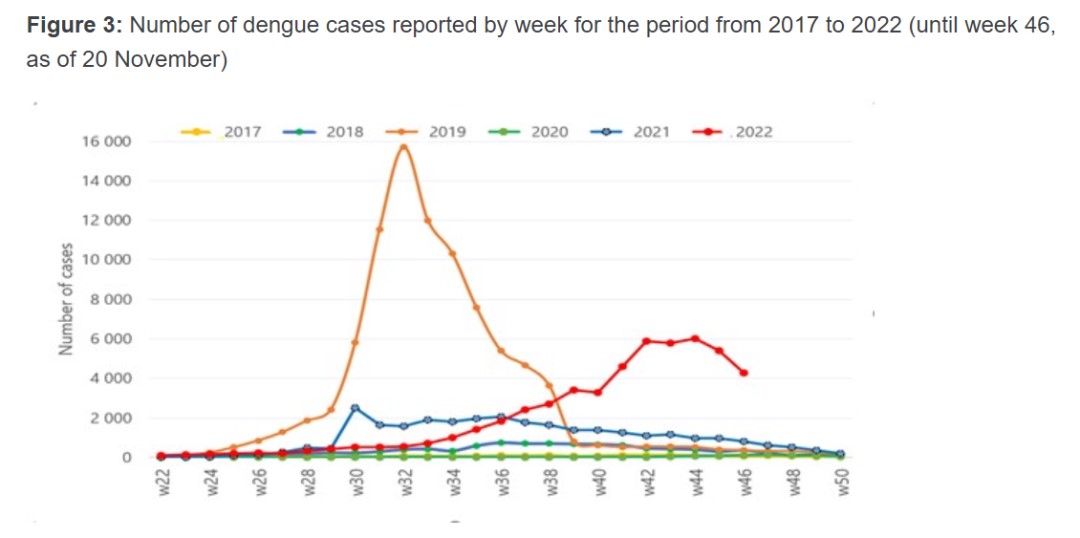
Dengue fever is an acute systemic infectious disease caused by the bite of a female mosquito carrying the Dengue virus (DENV)[1]. Dengue fever infects approximately 390 million people annually and affecting more than 120 countries, most severely in Africa, the Americas, Southeast Asia and the Western Pacific [2]. The spread of Dengue fever is now spreading to temperate and cold zones and higher altitudes as global warming increases, and the prevalence of serotypes is changing. Dengue fever has become a significant public health problem, and the increasing geographical spread of the virus, the number of cases and the severity of the disease pose a global threat to human health and socioeconomics [3].
1. Serotype
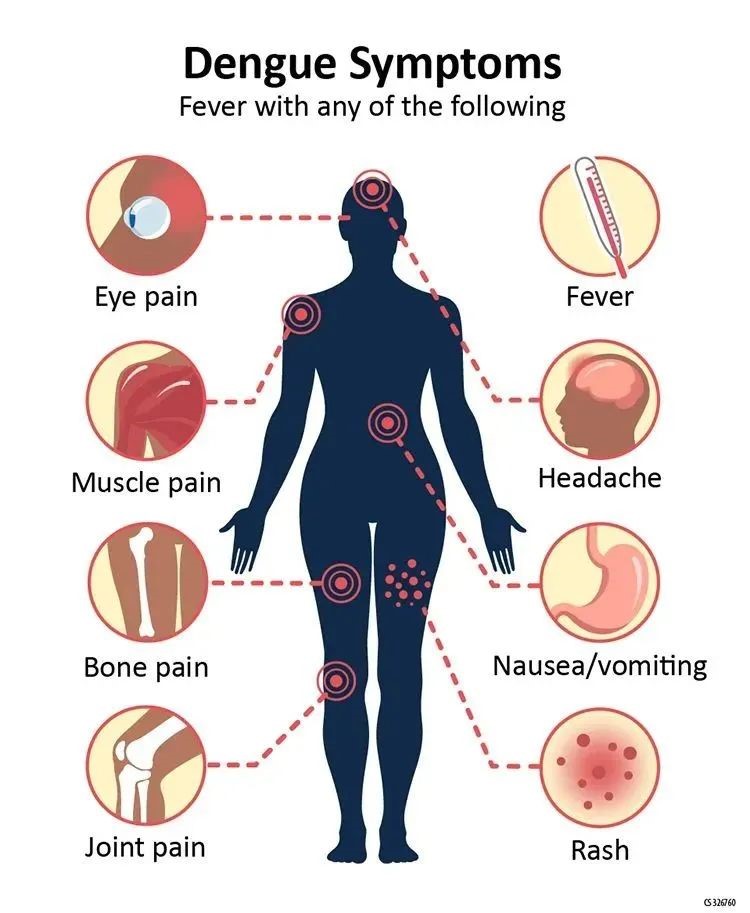
DENV contains four serotypes: DENV-1, DENV-2, DENV-3 and DENV-4; DENV-1, DENV-3, and DENV-4 contain five genotypes (GI ~GV) [4-6]. In 2013, Mustafa et al. [7] identified a fifth serotype, DENV-5, through virus isolation and gene sequence analysis in Malaysia, posing a new challenge for vaccine development.
2. Vectors
DENV is transmitted by two mosquito vectors, Aedes aegypti and Aedes albopictus [8]. DENV can be transmitted vertically. Aedes aegypti and Aedes albopictus prefer temperate climates. Domestic water storage and decorative plant containers, waste food and drink containers, drains, and buildings under construction are preferred sites for Aedes aegypti and Aedes albopictus to live and breed. One of the current measures to contain DF is to control the DENV vector by eliminating or managing the larval environment and using biological agents and insecticides to kill the larvae [9].
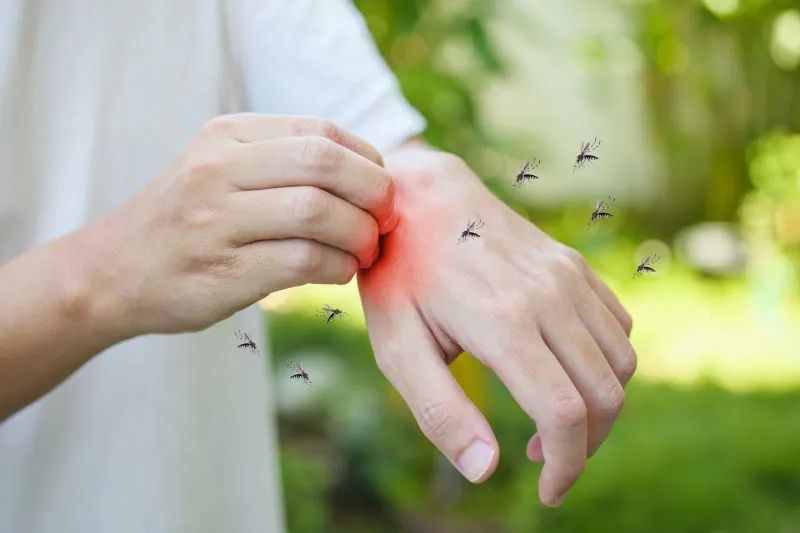
3. Global Epidemiology
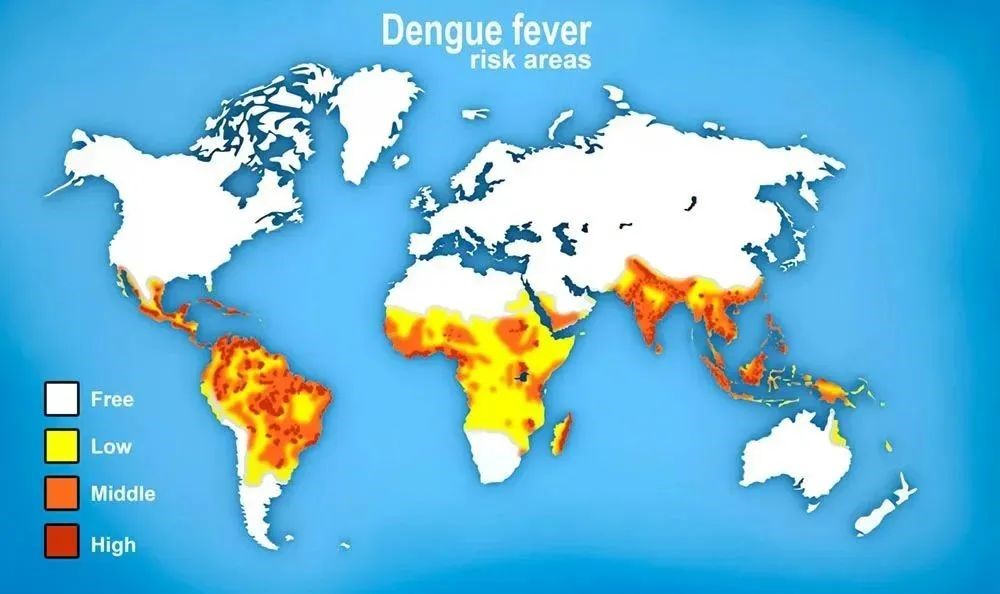
Resource:Healthdirect
Dengue fever is endemic in many countries in Southeast and South Asia, with incidences occurring throughout the year and showing clear seasonal peaks. Since June 2022, Pakistan has been hit by massive floods. The floods provided a habitat for mosquitoes to breed, and the aftermath made mosquito-borne infections susceptible to outbreaks or epidemics. September saw a surge in Dengue cases in Pakistan, with 19,190 new cases, accounting for 74% of the annual total. Throughout 2022, the cumulative number of Dengue cases in Pakistan has significantly exceeded the level of the same period in the previous four years [10]. The risk of further spread in Pakistan is high due to heavy rains and flooding, which have damaged many health facilities and displaced 7.9 million people. In Nepal, the number of Dengue cases has risen since the onset of the rainy season in July, with 23 156 new cases in September, accounting for 84% of the annual total. In Bangladesh, the Ministry of Health and Family Welfare has reported 52,807 laboratory-confirmed Dengue cases and 230 associated deaths since 1 January 2022, with a morbidity and mortality rate of 0.44% [11].
4. Summary
DENV is a significant public health problem in tropical and subtropical regions. DENV transmission is expanding, and the virus is becoming more infectious. In addition to being transmitted by mosquito vectors, DF can also be transmitted through blood, organ transplantation needle sticks, etc. DF infections are primarily seen in children and adolescents. The prevalence of DF is seasonal and climate-related, and global warming is expanding the geographical range of Aedes aegypti. With economic development, greater global accessibility and mobility of populations, DENV infections are exchanged in different regions. In the context of the new coronavirus epidemic, the dual transmission of DENV and novel coronaviruses has occurred in several countries, posing a severe threat to public health. According to WHO recommendations, there is no specific treatment for dengue infection. Therefore, early detection of cases, recognition of any early warning signs of severe Dengue and timely access to appropriate clinical management are critical elements of care to reduce the risk of severe Dengue complications and death due to Dengue fever.
5. Solution
Dengue fever in the acute febrile phase can be diagnosed early with the dengue antigen (NS1) test. NS1 is a non-structural protein of the dengue virus that is common to all dengue serotypes. It can be used to detect the earliest primary or secondary infection. Getein's Dengue NS1 Ag Fast Test Kit uses a fluorescent immunoassay to demonstrate results within 15 minutes. It has high sensitivity within 7 days of symptom, making it a simple, efficient, and high-quality option.
【References】
[1] GUTIERREZ-BARBOSA H, MEDINA-MORENO S, ZAPATA JC, et al. Dengue infections in Colombia: epidemiological trends of a hyperendemic country[J]. Trop Med Infect Dis, 2020, 5(4): 156.
[2] WANG Y, SI L L, GUO X L, et al. Substitution of the precursor peptide prevents anti-PRM antibody-mediated antibody-dependent enhancement of dengue virus infection[J]. Virus res, 2017, 15(229): 57-64.
[3] KARUNA R, YOKOKAWA F, WANG K, et al. A cyclic phosphoramidate prodrug of 2'-deoxy-2'-fluoro-2'-C-methy-lguanosine for the treatment of dengue infection [J]. Antimicrob Agents Chemother, 2020, 64 (12): 11-12.
[4] Rexliene J, Sridhar J. Genetic diversity and evolutionary dynamics of dengue isolates from India [J]. Virus disease,2019, 30(3) :354.
[5] de Bruycker -Nogueira F, Mir D, Dos Santos FB, et al. Evolutionary history and spatiotemporal dynamics of DENV-1 genotype V in the Americas[J]. Infect Genet Evol, 2016(45): 454-460.
[6] Sang S, Liu-Helmersson J, Quam MBM, et al. The evolutionary dynamics of DENV 4 genotype I over a 60-year period[J]. PLoS Negl Trop Dis,2019, 13(7): e0007592.
[7] Mustafa MS, Rasotgi V, Jain S, et al. Discovery of fifth serotype of dengue virus (DENV-5): A new public health dilemma in dengue control[J]. Med Armed Forces India, 2015,71(1):67-70.
[8] Surendran SN, Veluppillai T, Eswaramohan T, et al. Salinity tolerant Aedes aegypti and Ae. albopictus Infection with dengue virus and contribution to dengue transmission in a coastal peninsula[J]. Vector Borne Dis,2018,55(1):26-33.
[9] World Health Organization (28November 2022). Disease Outbreak News; Dengue – Bangladesh.
[10] World Health Organization. Dengue-Pakistan [EB/OL]. (2022-10-13) [2022-10-18].
[11] World Health Organization. Dengue-Nepal [EB/OL]. (2022-10-10) [2022-10-18].

Open WeChat and Scan the QR Code. Stay Tuned with Us.